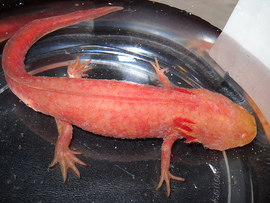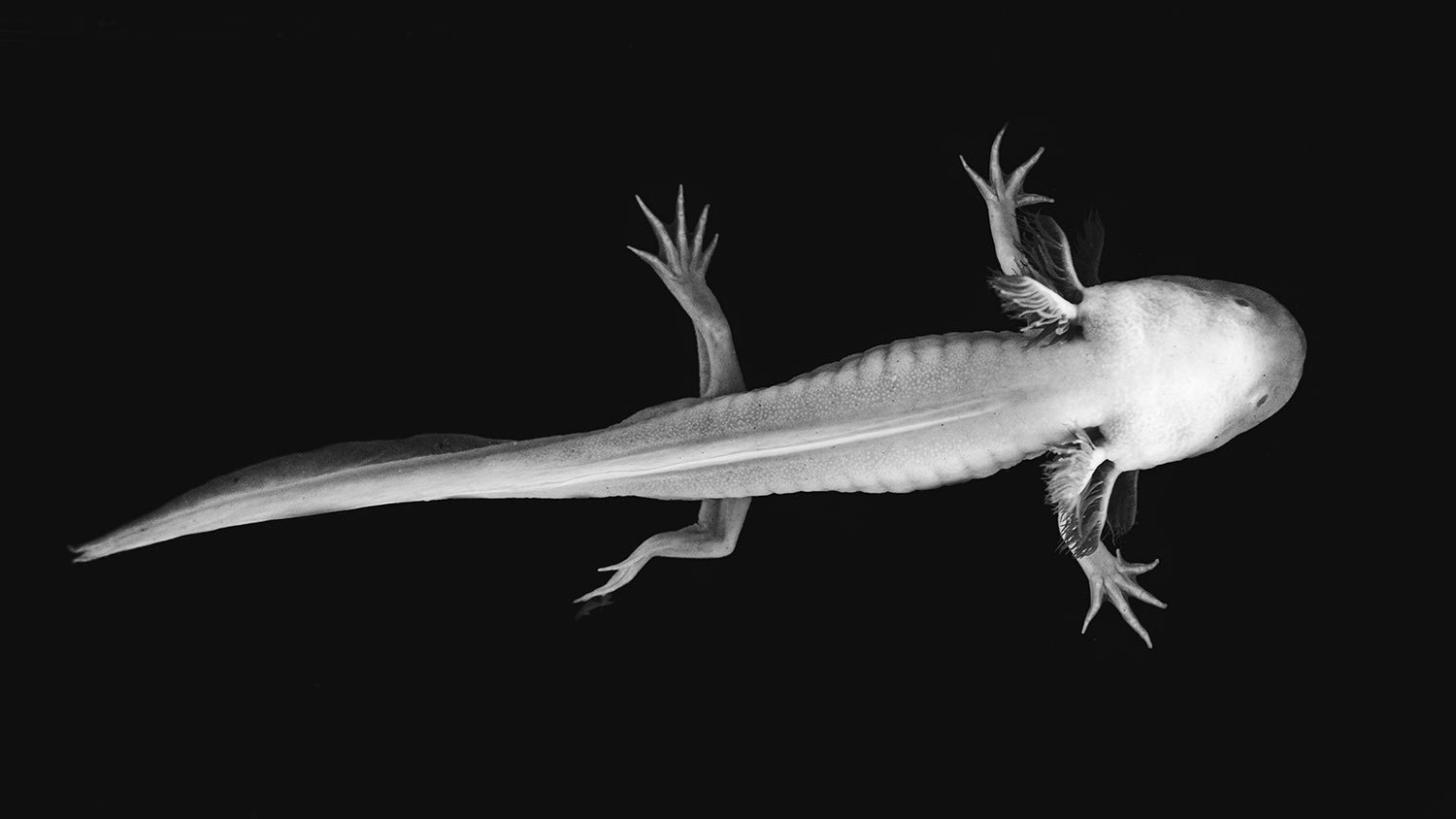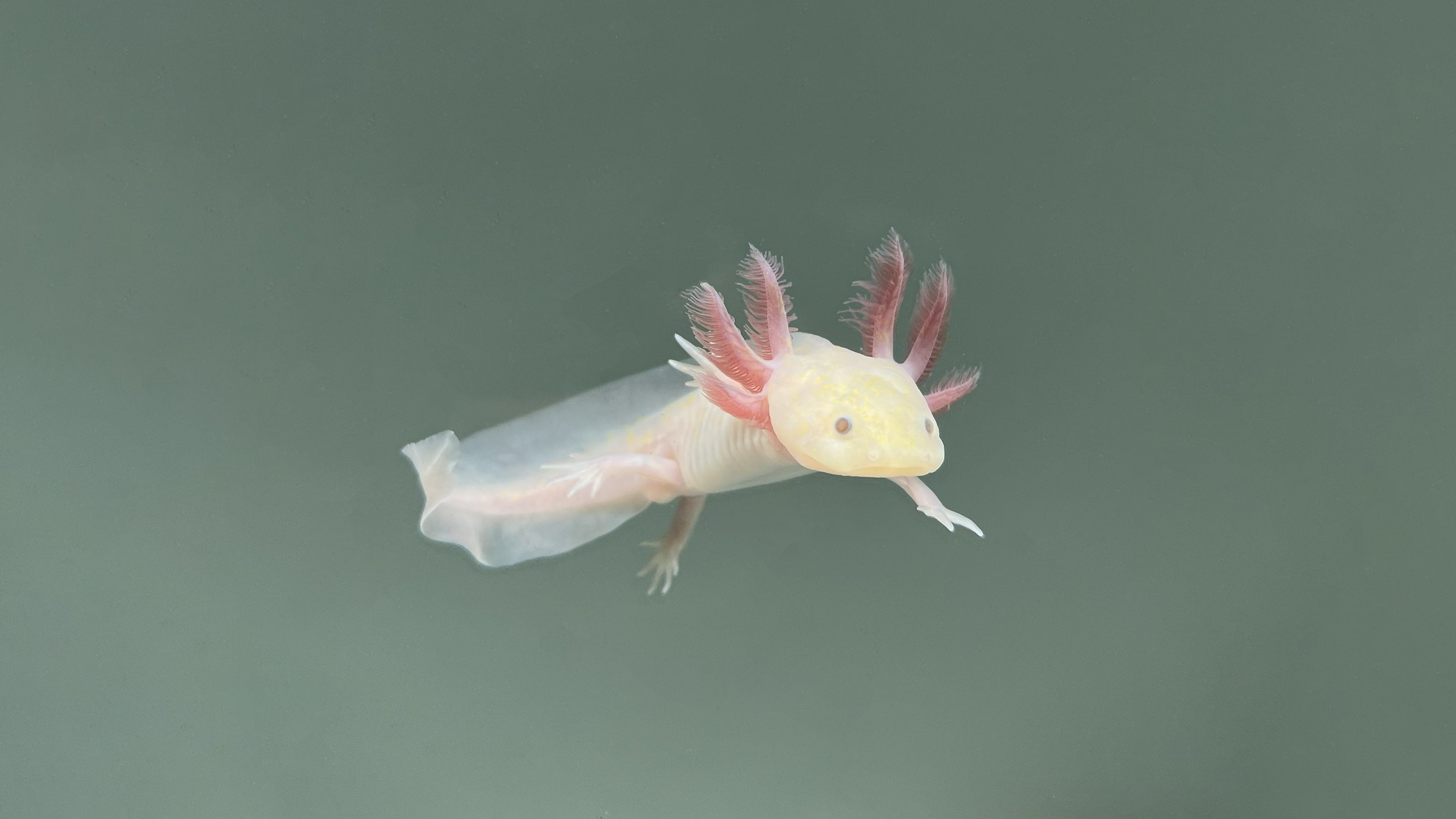Introduction
Even in a seemingly ideal environment, axolotls can sometimes develop stress and illness. Health issues found in axolotls such as fungus, lack of appetite, curled gills, bacterial infections, and more need to be treated as soon as possible. If your axolotl is showing signs of stress or illness, the most common reason is that there is something wrong with their aquarium environment.
Poor tank maintenance, improper water changes, and a lack of a healthy Nitrogen Cycle in the water can all cause your aquarium’s water to become unsafe for your pet. If your axolotl appears unwell, the first things you should always do are test your water parameters (see below) and read our guide titled How to Cycle an Aquarium. Once you have done these two things, continue reading below to learn more about stress and sickness in axolotls.
Checking your aquarium’s water parameters
You should test your aquarium’s water at least once a week to keep track of your parameters. Regular water checks will help prevent your aquarium’s water from becoming unsafe for your axolotl. For this purpose, we recommend using the Freshwater Master Test Kit by API. You can purchase it right now by clicking this link here or at your nearest Petco, PetSmart, or fish store. Alternatively, you may bring a sample of your water in a clean container to your local fish store and they will test your water parameters for you. Ideal water parameters are as follows:
- pH – Ideal: 7.4-7.6 | Acceptable: 6.5-8.0
- Ammonia – 0 parts per million
- Nitrates – Between 5 and 20 parts per million
- Nitrites – 0 parts per million
- Temperature – 60 - 68 °F; no higher than 72°F
Verifying your tank maintenance practices
Adding unconditioned tap water to your tank, performing large water changes (replacing more than 33% of the water in your aquarium at a time), and using tap water to clean your filter equipment and seeded media all may cause your aquarium to crash. If a tank “crashes,” it means the beneficial bacteria in the aquarium are dead, and the Nitrogen Cycle in the water has to restart itself. During this period, ammonia levels in the water can spike, causing the aquarium to be uncomfortable or even harmful to your axolotl. This happens because tap water has chemicals like chlorine and fluoride in it which keep humans safe, but are toxic to the good bacteria that keep your axolotl safe.
If your aquarium is properly cycled, you should perform a 25% water change every week to keep it clean. To do this, read our guide titled How to do a Water Change. If you’re unsure if your aquarium is properly cycled, read our guide titled How to Cycle an Aquarium. Also, be sure that you remove any uneaten food that your axolotl leaves behind after about fifteen minutes, to prevent decaying food from accumulating and causing ammonia levels in the water to spike and crash the tank.
To prevent your tank from crashing, you should clean all of your decorations and filter equipment in a separate container that has been filled with water from your aquarium. We recommend cleaning your tank supplies once per month, at the same time as your weekly water change.
Examining your tank environment
Be sure you do not have any of the following items in your axolotl’s aquarium:
- Gravel or small rocks – Axolotls may try to eat these, or simply ingest them accidentally, which can lead to impaction (a blockage) in their bowel and death. To prevent this, we recommend avoiding any rocks or decorations that are smaller than the size of the axolotl’s head. This way, you can be sure your pet doesn’t accidentally consume anything it shouldn’t.
- Unsafe dyes – These are usually found on sand and decor that owners add to their aquariums. Read the labels! If your product is labeled safe for aquatic pets, it should be okay for your axolotl.
- Sharp or jagged decorations – Axolotls have very poor eyesight, and may accidentally swim into sharp objects in your aquarium and hurt themselves.
- Aggressive tank mates – Some types of fish and even other axolotls may try to hurt your axolotl. Fish like tetras and guppies have been known to nip at axolotls’ gills and tails, thinking they’re food. If you are keeping multiple axolotls in the same aquarium, make sure they have plenty of room and are well fed. We recommend keeping no more than one axolotl in a 20 Gallon Long tank, or two axolotls in a 30-40 Gallon Breeder tank, and feeding every two or three days.
Signs of Stress
Most signs of stress in axolotls can be addressed by testing your water parameters. Water quality is the single most common underlying cause of most of the symptoms listed in this guide. If your axolotl appears unhealthy or stressed, always perform a water check and verify that your tank is properly cycled first.
Curled Gills
Curled gills are one of the first and most common signs of a stressed or unhappy axolotl. If your axolotl’s gills appear curved outwards, towards the front of its face, it most likely means that your water parameters are off. Perform a water check and if necessary, a water change as well. If your axolotl’s gills remain curved after verifying good water quality, consult a specialist or give our team a call.
Gill Deterioration - Axolotl Losing External Gills
Deterioration of axolotls’ gills is almost always caused by high ammonia levels in the water. High nitrate and nitrite levels can also contribute to the issue. Gill deterioration is most often a symptom of poor aquarium maintenance or a lacking Nitrogen Cycle in the environment; however, another cause of gill deterioration can be chemical contamination in the water. If you suspect your water is contaminated, read our guide titled How to Fix a Contaminated Aquarium.
Once you have verified that:
- Your axolotl tank has a healthy Nitrogen Cycle
- The water parameters are good
- You are using the proper protocols to clean and maintain your equipment
Review your weekly maintenance routine. We recommend performing a 25% water change once per week to reduce ammonia, nitrate, and nitrite levels—a healthy aquarium will have little to no ammonia or nitrites. If you are doing all of the above and are still having trouble, it might be time to clean your filter. To do this, read our guide titled How To Clean Your Aquarium Filter.
If none of the above seems to help, you can seek assistance by sharing your concerns with experienced axolotl keepers on Facebook, reference articles via caudata.org, or reach out to the Axolotl Planet team as soon as possible.
Curled Tail Tip
Curling at the tip of an axolotl’s tail can be a more serious sign that the animal is experiencing great stress or illness. If your axolotl’s tail appears to be curled abnormally, you should check your aquarium’s water parameters and Nitrogen Cycle. If the animal’s environment is okay, then it is possible that your axolotl is very ill. We recommend consulting a specialist or reaching out to the Axolotl Planet team as soon as possible.
Axolotl Won't Eat - Loss of Appetite
A loss of appetite is one of the first signs of stress in axolotls. This symptom is most often caused by poor water quality or high water temperature (above 72°F) in your aquarium. Perform a water test and make sure that your water temperature is at or below 68°F.
Loss of appetite can also be caused by aggressive tank mates, contaminated water, or an infection. Make sure your pet has plenty of room to move around its habitat, and that it is not being stressed or harassed by another resident of the tank. If you suspect that your tank has been contaminated by chemicals, read our guide titled How to Fix a Contaminated Aquarium.
If your axolotl refuses to eat for longer than a week, reach out to a specialist or consult the Axolotl Planet team as soon as possible.
Axolotl Taking Frequent Gulps of Air
Axolotls have the ability to breathe in air as well as water, so it is not uncommon to witness them swim to get air from the surface when they need more oxygen.
However, if your axolotl starts doing this frequently, it’s probably a sign that their water is too warm. Check the temperature; it should be between 65–70°F, and never higher than 72°F.
Axolotl is Floating in the Water - Or Floating Upside Down
Most of the time, floating is completely normal for a healthy axolotl. However, there are some circumstances where floating could be an early sign of a more serious issue. If your axolotl is floating upside down but is still very much alive and otherwise active, it is likely that air has entered its gastric system and is disrupting the animal’s natural buoyancy. If you suspect this has happened to your axolotl, consult a specialist or reach out to the Axolotl Planet team immediately—veterinary care is often required in these situations.
Axolotl is Very Active - Frantic Swimming
Frantic swimming generally indicates that something is causing pain for your axolotl. Most commonly, this behavior is seen when ammonia, nitrite, and nitrate levels in the water are too high. However, it is also seen when the tank water becomes contaminated with tap water or other chemicals.
If your axolotl appears to be swimming frantically, verify your tank’s water is uncontaminated, and perform a water test.
If the water tests come back normal, check the flow of your filter. If the filter is running too high, the axolotl can be forced to constantly swim due to the current of the tank. A fast-paced current in the tank will stress out your axolotl as it will be in perpetual motion. Axolotls that are constantly having to readjust their positioning or swim will become exhausted as they prefer to be sedentary.
Lack of Responsiveness
When axolotls are stressed, they may sometimes be unphased by interaction, including attempts at feeding.
Axolotl is Pale - Loss of Color in Body or Gills
Axolotls may lose pigmentation when resting and become either lighter or darker depending on the color of their environment. Under different circumstances, it can be seen as a sign of potential stress or blood loss if seriously injured. When axolotls pass away, they will completely lack color.
Health Issues and Sickness
In this section, we list more severe cases of axolotl health issues and our recommended treatment(s) for them. Note that once you have corrected your axolotl's condition, proceed to practice regular maintenance otherwise their illness/infection may come back again.
Fungus - Axolotl has White or Black Spots
Fungus is one of the most common problems you will encounter if your aquarium is not set up or maintained properly. It looks like a translucent, white, fuzzy matter that develops around an axolotl’s gills, head, and legs. If an axolotl is wounded, fungus may also grow on and around the affected region. An example of this can be seen in the image below:
While fungus is quite easy to treat, it is important to deal with the situation carefully and urgently. Oftentimes, minor cases of fungus can be corrected simply by practicing proper care and maintenance, but if untreated, a fungal infection can quickly spread and kill an axolotl.
Here are steps you can take to start the treatment and recovery process for an axolotl with a fungal infection:
Black Tea Baths
Black tea is a powerful anti-fungal agent and contains strong tannins that can help treat fungal infections. However, the concentration of tannins that black tea can release into the water is much stronger than that of Indian Almond Leaves and should only be used for bathing your axolotl in for short periods of time. To perform a tea bath on your axolotl ensure that you have regular caffeinated black tea bags with no additional flavors or additives on hand as well as a plastic tub or bowel large enough for your axolotl to fully stretch out in. Then, follow these steps:
- Fill the tub with 1 - 2 gallons of conditioned tap water.
- Boil 1 cup of tea, using conditioned tap water, per gallon of water in the tub.
- Allow the tea to steep for at least 15 minutes to thoroughly diffuse the tannins.
- Allow the tea to cool to room temperature. You can also place it in your refrigerator to cool it off quickly.
- Pour the tea into the tub.
- Place your axolotl into the tub for no longer than 10 minutes.
You can give a tea bath to your axolotl once daily until the fungal infection has been cured. Black tea baths are best to use for minor fungal infections that are caught early on. For more aggressive infections, stronger medications or veterinary intervention may be necessary to heal your axolotl.
MinnFinn Dosage
For more aggressive cases of fungus, a broad-spectrum treatment solution may be in your best interest. While it doesn’t specifically mention axolotl health, we recommend MinnFinn Mini’s Broad Spectrum Treatment as it is one of the most gentle and effective products to cure axolotl fungus. Once the product arrives at your home, administer the minimal dosage according to the directions on the package. This can be used to treat both minor and severe infections, however, recovery time may vary based on the condition of your axolotl. Treating your axolotl in its aquarium will ensure that any other inhabitants exposed to the fungus will be treated as well, even if they do not have fungus.
Hydrogen Peroxide Application
NOTE: This method should only be used in the most severe cases of fungus and only if approved by a veterinarian. Examples include gills being completely decomposed by and/or covered with fungus as well as instances where 30% or more of your axolotl’s body is covered in fungus.
- After thoroughly rinsing your hands with very warm water (do not use soap as residues may irritate your axolotl even more), dry them completely and do the following:
- With one hand, hold your axolotl gently above the surface of the water, but tight enough to ensure that it does not slip away.
- With the other hand, use a Q-Tip to dip into the hydrogen peroxide (your standard 3% product in the brown bottle), then quickly and carefully swab the infected areas of your axolotl.
- Leave your axolotl out of water for about 5 seconds and return it to the water.
- After applying the hydrogen peroxide, you should see the affected area(s) fizz up. It might appear to be a little cloudy, however, it will return to normal shortly. As mentioned above, this method should only be used for the most severe fungal infections. It’s also important to make sure that your tank’s water parameters are at healthy levels, otherwise the fungus is likely to come back and do more harm.
By the next day, your axolotl should look significantly better. If large amounts of fungus are still visible, you can repeat the hydrogen peroxide swab.
Wounds / Physical Damage - Axolotl Missing an Arm or Leg
Bites, cuts, and missing limbs are common axolotl injuries. Luckily, axolotls are an extremely unique species that have the ability to regrow almost any part of their body—even parts of their spine and brain! If your axolotl gets injured, you don’t need to worry very much.
Depending on the severity of the damage, how old your axolotl is (older axolotls tend to heal slower than younger ones), the genetics of your axolotl, how clean their water is, how often you feed it, the quality of food you feed it (pellets and bloodworms can be unhealthy over time), and precautionary acts you take to ensure its health, the wound can take anywhere from a couple weeks to several months before it heals completely.
Having clean, cycled aquarium water will help your pet heal faster. We also recommend purchasing some Indian almond leaves, which have antibacterial properties and adding them to your tank water. The leaves will turn the water to a slightly yellow-brown hue but don’t worry, it doesn’t mean your water is dirty or unsafe!
Continue testing your water once per week with a Freshwater Master Test Kit to make sure your water parameters are at healthy levels. A clean environment will reduce the chances of infection as well as speed up the healing process.
Damaged Slime Coat
Acting as a protective barrier against foreign bacteria, fungus, infection, and temperature regulation, an axolotl’s slime coat is crucial when it comes to the overall health of the animal. Unhealthy water parameters, sharp decorations, and/or aggressive tank mates can damage the slime coat of your axolotl.
Given that it is in a healthy environment where its water parameters are safe, the slime coat should heal on its own within just a few weeks depending on the severity of the damage.
During this time, keep the water temperature as low as you can (at least below 68°F) and make sure you are conducting routine maintenance to keep the water clean. A Freshwater Master Test Kit will help you determine where your water parameters are at while your axolotl heals. Indian almond leaves will also help boost your axolotls’ immunity to disease and infection during this time.
Ammonia/Chemical Burns - Axolotl is Red
Ammonia and chemical burns are one of the most dangerous and painful conditions your axolotl can endure and must be treated immediately. An axolotl with ammonia/chemical burns will appear bright red and possibly have their gills completely deteriorated. See below:
Once you have determined whether or not your axolotl is suffering from burns, you should immediately:
Tub Your Axolotl
- Quickly tub your axolotl in any clean, empty aquarium, large bowl, plastic tub or Tupperware. If using bowls or Tupperware, be sure they are free from harmful residues (such as soap) which can cause more irritation.
- Add clean, dechlorinated tap water to your container. If the water is much warmer than the temperature of water your axolotl is in, quickly cool it down with ice cubes and water conditioner. Any frozen materials may help if you do not have ice, however, be sure that it is clean and free from residues. Keeping the water as cool as possible is key to soothing your axolotl's skin. Having plenty of frozen water bottles on hand is useful to maintaining a cool temperature for your axolotl. It is extremely important to perform twice daily water changes on the tub to prevent any further ammonia build up and skin irritation. If the ammonia burn is severe enough, it may be necessary to seek out veterinary guidance.
- Clean Your Tank - If your tank has been contaminated with chemicals, you will have to completely drain and thoroughly clean the aquarium unless you have another suitable axolotl tank already up and running, everything inside of it. For more information, visit our article on How to Fix a Contaminated Aquarium. All of your filter media and anything that the chemicals have come in contact with must be cleaned as well.
- You can clean everything with tap water if chemicals were present because all of the beneficial bacteria has already died.
- Next, set up your tank again and consider adding precautionary measures to prevent contamination from happening again. You will also have to cycle your aquarium all over again, but you can reduce the amount of time it takes by checking out our article, How To Cycle Your Aquarium.
If your axolotl has suffered from ammonia burns, you will need to allow your tank to cycle. Adding axolotls to an uncycled tank, not doing regular maintenance, adding too many inhabitants to your tank at once, and/or over-feeding can spike your ammonia levels and potentially crash your tank (when all of the beneficial bacteria dies). Our article on How To Cycle Your Aquarium may be useful during this situation as well.
Reach out to our team for assistance as every situation is different. Within 24 hours, one of our axolotl specialists will help you correct the situation.
Bacterial Infections
Poor water quality, aggressive tank mates, and/or infected food (most common when feeding expired and/or live foods) can lead to skin infections such as Proteus, Pseudomonas, Acinetobacter, Mima, and Alcaligenes. Do your best to prevent them by keeping your tank clean and being attentive towards your axolotl’s health. Other common types of bacterial infections include Aeromonas spp. and Psuedomonas spp. With bacterial infections axolotls will become inappetant, and in advanced stages may develop ascites (bloating due to fluid retention). Chances of survival in axolotls with advanced infections is very poor and euthanasia may be the best option. In the early stages of a bacterial infection, administering antibiotics can be successful in treating the axolotl. Oral administration is usually more effective than treating the water of your axolotl's aquarium. Mixing antibiotics such as enroflaxin, getamycin, and amikacin into wet food, such as thawed brine shrimp or repashy grub pies, and freezing it prior to feeding is usually and effective method of administering medicine orally to axolotls.
Some bacterial infections like Mycobacteriosis show identical symptoms to Septicaemia. Contraction of Mycobacteriosis is similar to other forms of infection. A combination of consistently poor water quality, high water temperatures, or consuming live food predisposes an axolotl to Mycobacteriosis. There is no treatment for Mycbacteriosis. Consult your veterinarian if you suspect your axolotl to be suffering from Mycobacteriosis.
Parasitic Infection
Similar to bacterial infection, parasitic infections are caused by poor water quality and exposure to live foods. Parasites that afflict axolotls come in different forms. There are ectoparasitic parasites (these live on the outside of the host such as the skin and gills) and enteric parasites (these live inside of their host). Each form of these parasites has its own requirements for treatment and correct identification of the parasite is paramount to curing your axolotl. Consult a vet for correct identification of any parasites that may be infecting your axolotl. Common parasites that afflict axolotls include: Trichodina, Ichthyobodo, Hexamita, and Opalina. Many protozoan ectoparasites can be treated with formalin and protozoan parasites like Hexamita and Opalina can be treated with metronidazole. Consult your veterinarian about effective treatment options if you are unable to correctly identify the type of parasite afflicting your axolotl.
Axolotls undergoing treatment must be treated in a hospital tank or a tub as certain types of parasites, such as Hexamita, can live for quite a long time without a host and may be prevalent inside of the tank. Treating the axolotl in the tank will be ineffective as the parasites may simply reinfect the axolotl. If your axolotl has been infected with parasites then it will be necessary to completely tear down, disinfect, dry out, and re-do your tank completely to fully rid yourself of any possible parasites that could be lurking inside your tank.
Conclusion
Overall, axolotls are quite resilient to infections and disease. Most of the issues mentioned in this article can be prevented simply by practicing proper husbandry (keeping up with regular aquarium maintenance and feeding a proper diet once every 2-3 days)! At the first sign of any suspected health-related problems, test your water parameters and try to determine what might be happening based on everything you learned today. If you can’t pinpoint exactly what the problem is, reach out to our team and one of our axolotl experts will be happy to help!





Leave a comment
This site is protected by hCaptcha and the hCaptcha Privacy Policy and Terms of Service apply.